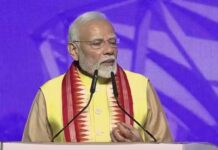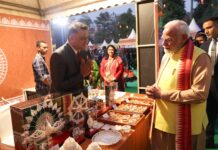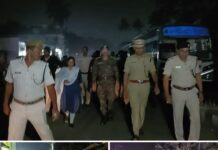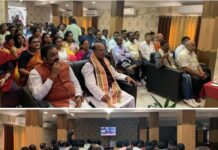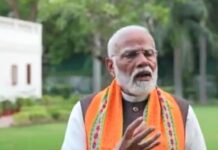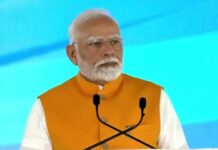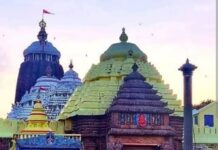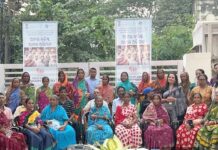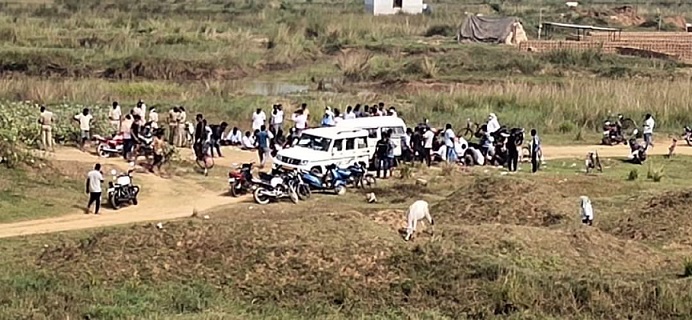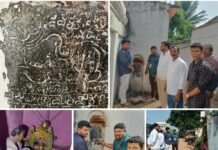By Anurjay Dhal
BHUBANESWAR: The 2 leading faces of the ruling BJD establishments manning the costal Aul and Chandabali Assembly segments of Kendrapara and Bhadrak and enjoying the trust of Chief Minister Naveen Patnaik, read Pratap Keshari Deb aka ‘Sana Babu’, a 4th times Law Maker and former Minister and Byamokesh Ray aka Bapi Ray, a 2 times, MLA , on Wednesday received a major jolt after the agitating farmers under the banner of Kharasrota Banchao Sangram Samiti flooded questions on the visiting survey team of Hyderabad based Megha Engineering India Ltd, which was awarded the Bhadrak project at Gadagadi Ghat bridge under Rajkanika block of Kendrapara, and forced the team return back from the spot without conducting any survey work for the much talked about drinking water projects under Vasudha scheme worth Rs 892 Crore for Bhadrak-Rs 268.11 Crore for Aul-Kanika. Sources said, Megha Engineering India Ltd, which was awarded the Bhadrak project, started a small fabrication unit located in Hyderabad in 1989 and in 90s , it ventures into projects in irrigation and drinking water sectors, will face more tough time ahead in executing the project.
Kendrapara ADM Basant Rout, Pattamundai SDPO Rajan Deo and IIC of Aul and Kanika PS were present at the spot and could not able the pacify the anger of the agitating farmers and failed to provide adequate security to the visiting survey team, as a result of which, they returned back empty handed without conducting any survey work sources said.
It may be noted here that, Chandabali BJD MLA and in charge of Party’s Youth affairs, Ray had ridiculed the agitation and had targeted former Congress MLA Deba Sharma while his Aul Colleague Pratap Deb presenting the present status of water level under the Gadagadi Ghat bridge in the river, had also questioned the motives of the Sangam Samiti, which is spearheading the agitation since the State Government’s decision to lift water from river Kharasrota for Bhadrak project came to fore.
The survey team of Megha Engineering India Ltd, which got the tender work for Bhadrak project, set aback after the agitating farmers, who were sitting on agitation, holding protest meetings and pada yatras threw several questions on them and asked them to return back and come with a complete assurances that, water will not be lifted from Kharasrota from Bhadrak project and only would be allowed to use for Aul-Kanika project. When contacted Engineer-in-Chief, RWSS, Abhaya Kumar Biswal, said, it was the District Collector and SP to see the law and order situation. The technical bids for the Aul-Kanika project will be opened on Friday, EIC Biswal informed.
Pratap Deb for the first time in his 20 years long political career including 4th terms in Assembly, a Cabinet , Rajya Sabha berth and Chairman, Housing Board, never faced such local resistance as he is facing since Government decided to lift water from Kharasrota for Bhadrak.
With local protesting strongly , the water issue likely to snowballed into a major controversy with the Sangram Samiti calling a massive public meeting on November 22 at Gagagadi Ghat Ground , where several water experts, environmentalists, civil rights activists and political leaders are expected to join.
According to a report on ground water level that published in 2017 for Kendrapara’s Rajkanika, Rajnagar, Mahakalpada and Garadapur blocks, it was stated that ground water level reported salt water while ground water level in Bhadrak’s Tihidi, Basudevpur and Dhamnagar blocks were started to be safe water. If that the case, as to why Government is insisting on lifting water from Kharasrota for Bhadrak, which has 4 major rivers like Baitarani, Salandi ,Mantei and Kansabansa. As per the dynamic ground water resources assessment of India-2017, Kendrapara has 5445.19 HAM ground water while Bhadrak has 17021.48 HAM, which is 3 times more than Kendrapara but why water from Kharasrota to be used for Bhadrak, the Government should explain it. Kendrapara District Irrigation Report dated on 25.04.2016 under Pradhan Mantri Krushi Surekhya Yojana, page-74, it was stated that in 2020 demand for water in Kendrapara will be around 1.463 BCM while its water level is now stands at 996 BCM.
Water experts apprehends that the commercial coal mining and as well as iron ore mining badly hitting major rivers and its tributaries “The new proposed mining in 9 new Coal blocks that include 8 in Angul alone, will add to the water scarcity not only in Angul-Talcher belt but also a number of local streams draining into Brahmani are most likely to be lost forever into the mining areas, affecting the water availability and quality of water of Brahmani and its tributaries like Kharasrota,” said Ranjan Kumar Panda, Convenor, Odisha Water Initiative. Coal mining has serious implications on the groundwater levels, local water bodies and the ecology and it would badly hit Brahmani and Kharasrota,” Panda said. Tens of thousands of farmers depending on Brahmani and its tributaries will feel the heat, he argued.Another activist questions as to why Government insisting on River Kharasrota to supply water to Bhadrak. “Any kickback behind the scenes,” he added.
It may be noted that at about 480 kilometres (300 mi) long, the Brahmani river is the second longest river in Odisha after the Mahanadi. However, if its constituent rivers are included its length extends to about 799 kilometres (496 mi), of which 541 kilometres (336 mi) are in Odisha. It has a catchment area of about 39,033 square kilometres (15,071 sq mi) in Odisha alone. Apart from the Rengali dam, there also exists a barrage shortly before Talcher called Samal Barrage. The Jokadia and the Jenapur anicuts are the other irrigation projects on the river. Near its mouth, the river is also crossed by the Odisha Coast Canal that takes water from it.
After assuming the name of Brahmani, the river crosses the Tamra and Jharbera forests, skirting along National Highway 23. It then passes the town of Bonaigarh in Sundargarh district before being dammed at Rengali in Anugul district. A large reservoir of the same name is created as a consequence. It then flows through the towns of Talcher and Dhenkanal before splitting up into two streams. The main stream flows by the town of Jajpur Road beyond which it is crossed by National Highway 16 and the Kolkata-Chennai mainline of East Coast Railway. The branch stream called Kimiria receives the waters of the Birupa (a distributary of the Mahanadi, Kelua and Genguti before re joining the main stream at Indupur. It then flows crisscrossing through Pattamundai. The river then receives the Kharsuan aka Kharasrota, on its left bank before merging with the Baitarani, a major river, to form the Dhamra estuary. Officials however argued that water coming from Jokadia Dam to River Brahmani and Kharasrota is about 10% and 90 % respectively but Government considering in 50-50 ratio. As Kharasrota is deeper than Brahmani, it is housing more water and for Bhadrak project, Government will only use 2% of it from Kharasrota while rest 48% with people of Rajkanika and Aul.
Citing the Central Water Commission guidelines, officials in RWSS said, “as per law, water is first meant for drinking, then agriculture and last for industrial and commercial purposes but unfortunate that two projects including Rs 892 Crore for Bhadrak and Rs Rs 268.11 Crore for Rajkanika and Aul in Kendrapara were only meant for drinking water supply and purely for welfare of two coastal districts facing crisis of clean and safe water,” they added.
Local farmers in Rajkanika and Aul blocks are arguing that while preparing the project for Bhadrak, the State Government had skipped rivers Baitarani, Salandi, Mantei and Kansabansa which are major rivers in the State and instead preferred to extract water from Kharasrota, the smallest river in the State.
Locals living both sides of River Kharasrota ,feels their lifeline will be dried if water lifted for two projects. Sources also maintained that, if local resistance continues against Bhadrak project, Government may drop Rajkanika-Aul project and lift water from Jajpur side to feed people of Bhadrak. EIC RWSS Biswal, however maintained that both project are intended for welfare of people of Kendrapara and Bhadrak and all apprehensions have been addressed properly before execution of these mega drinking water projects.
Local farmers in some 60 Panchayats of Rajkanika and Aul have been protesting over water lifting from River Kharasrota for Bhadrak district and they feared their agricultural activities will hit due to shortage of water. The farmers agitation more or less been carried by local Congress and BJP leaders. “This clearly overlooked the fact that the project could adversely impact the people of Rajakanika and Aul blocks in the Kendrapara district who are dependent upon their drinking and agricultural requirements from river Kharasrota” a NGT order said. The project would also adversely affect the entire Bhitarakanika National Park as it is dependent for its survival on this river which is the only source of fresh water as the other rivers are saline in nature, locals alleged.
Over the last decades because of growth of industries on the river side near Rourkela, Angul-Talcher and Sukinda regions and the discharge of effluents by heavy and medium industries into the river coupled with the effluent discharge from urban centers, the entire stretch of the Brahmani river from Rourkela to the sea has been highly polluted with the result that not only the waters have become undrinkable and unbathable, but the aquatic life has also vanished completely and accordingly it is imperative that Brahmani Action Plan needs to be formulated and implemented together with other effective measures aimed at saving the river from pollution and providing water for drinking and bathing purposes to the people in the region. Brahmani River, which origin in the Chhotanagpur Plateau of Bihar and flows through the districts of Sundergarh, Angul, Deogarh, Dhenkanal, Jajpur and Kendrapara, has been highly polluted during the last several decades because of the growth of industries on the riverside near Rourkela, Angul-Talcher and Sukinda regions so much so that the waters have been contaminated to such an extent that aquatic life has vanished completely and lakhs of fishermen have lost their livelihood for all times to come.


